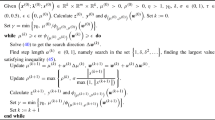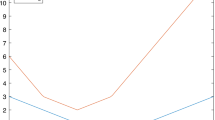Abstract
This paper emphasizes the great potential applicability of the so-called Haar's dual problem, in linear semi-infinite programming, and analyzes its properties in order to its reduction to an ordinary linear program, its sequential approximation through finite subprograms, as well as to its numerical solution by feasible directions strategies.
Zusammenfassung
Diese Arbeit unterstreicht die Anwendbarkeit des sogenannten Dualproblems von Haar in linearer semi-infiniter Optimierung und analysiert seine Eigenschaften. Dies geschieht im Hinblick auf eine Reduktion in ein gewöhnliches lineares Optimierungsproblem, eine sequentielle Approximation durch endliche Teilprobleme und auch zum Finden einer numerischen Lösung durch Verfahren der zulässigen Richtungen.
Similar content being viewed by others
References
Anderson EJ, Nash P (1987) Linear Programming in Infinite-Dimensional Spaces. John Wiley & Sons, Chichester New York Brisbane Toronto Singapore
Berskanskij IM (1974) Application of the inverse matrix method to the solution of linear programming problems with an infinite set of vectorial conditions. In Mathematical Methods in Economic Investigations. MR 48 □ 13245, Moscow
Blum E, Oettli W (1975) Mathematische Optimierung. Springer, Berlin Heidelberg New York
Charnes A, Cooper WW, Kortanek KO (1962) Duality, Haar programs and finite sequence spaces. Proc Nat Acad Sci USA 48: 783–786
Charnes A, Cooper WW, Kortanek KO (1963) Duality in semi-infinite programs and some works of Haar and Carathéodory. Manag Sci 9: 209–228
Charnes A, Cooper WW, Kortanek KO (1969) On the theory of semi-infinite programming and a generalization of the Kuhn-Tucker saddle point theorem for arbitrary convex functions. Nav Res Log 16: 41–51
Charnes A, Cooper WW, Rhodes E (1978) Measuring the efficiency of decision making units. Eur J Oper Res 2: 429–444
Debreu G (1951) The coefficient of resource utilization. Econometrica 19: 273–292
Farrell MJ (1957) The measurement of production efficiency. J Royal Stat Soc Ser A General 120: 253–281
Fischer T (1991) Strong unicity and alternation for linear optimization. J Opt Theor Appl 69: 251–267
Glashoff K (1979) Semi-infinite programming. Springer, Berlin Heidelberg New York
Glashoff K, Gustafson SÅ (1983) Linear Optimization and Approximation. Springer, Berlin Heidelberg New York
Goberna MA, Jornet V (1988) Geometric fundamentals of the simplex method in semi-infinite programming. OR Spektrum 10: 145–152
Goberna MA, Lopez MA (1987) Reduction and discrete approximation in linear semi-infinite programming. Optimization 18: 643–658
Hakimi SL (1963) Optimum distribution of switching centers and the absolute centers and medians of a graph. Oper Res 12: 450–459
Hettich R, Kortanek KO (1993) Semi-infinite programming: Theory, methods and applications. SIAM Rev 35: 380–425
Hettich R, Zencke P (1982) Numerische Methoden der Approximation und Semi-Infiniten Optimierung. Teubner, Stuttgart
Juhnke F (1988) Inradius and Dicke konvexer Körper aus optimierungstheoretischer Sicht. Beiträge Algebra Geom 27: 13–20
Juhnke F (1989) Das Umkugelproblem und lineare semi-infinite Optimierung. Beiträge Algebra Geom 28: 147–156
Karlin S, Studden WJ (1966) Tchebycheff Systems: With Applications in Analysis and Statistics. Interscience, New York London Sidney
Klostermair A (1976) Austauschalgorithmen zur Lösung konvexer Optimierungsaufgaben. Diplomarbeit, Univ. München
Kortanek KO (1977) Constructing a perfect duality in infinite programming. Appl Math Opt 3: 357–372
Kortanek KO, Strojwas HM (1985) On constraint sets of infinite linear programs over ordered fields. Math Progr 20: 129–143
Kosmol P (1991) Optimierung und Approximation. W. de Gruyter, Berlin New York
Lewis AS (1993) Consistency of moment systems. Department of combinatorics and optimization. University of Waterloo, Waterloo, Ontario, Canada (12 August), pp 1–32
Lovell CAK (1994) Linear programming approaches to the measurement and analysis of productive efficiency. Tr Inv Operativa 2: 175–223
Nash P (1984) Algebraic fundamentals of linear programming. In: Anderson EJ, Philpott A (eds) Infinite programming. Springer, Berlin Heidelberg New York, pp 37–52
Roth R (1969) Computer solutions to minimum-cover problems. Oper Res 17: 455–465
Rubinstein GS (1981) A comment on Voigt's paper “A duality theorem for linear semi-infinite programming” (in russian). Optimization. Academic Press, Orlando London
Sawaragi Y, Nakayama H, Tanino T (1985) Theory of multi-objective optimization. Academic Press, Orlando London
Seiford LH (1990) A bibliography of data envelopment analysis (1978–1990). Department of Industrial Engineering and Operations Research. University of Massachusetts, Amherst, Massachusetts
Voigt H (1981) Ein Dualitätssatz der semi-infiniten linearen Optimierung. Optimization 12: 27–30
Author information
Authors and Affiliations
Additional information
This research has been partially supported by DGICYT of Spain, Grant PB93-0943 and Generalitat Valenciana, Grant GV-2219/94.
Rights and permissions
About this article
Cite this article
Goberna, M.A., Jornet, V. On Haar's dual problem. OR Spektrum 18, 209–217 (1996). https://doi.org/10.1007/BF01540158
Received:
Accepted:
Issue Date:
DOI: https://doi.org/10.1007/BF01540158




